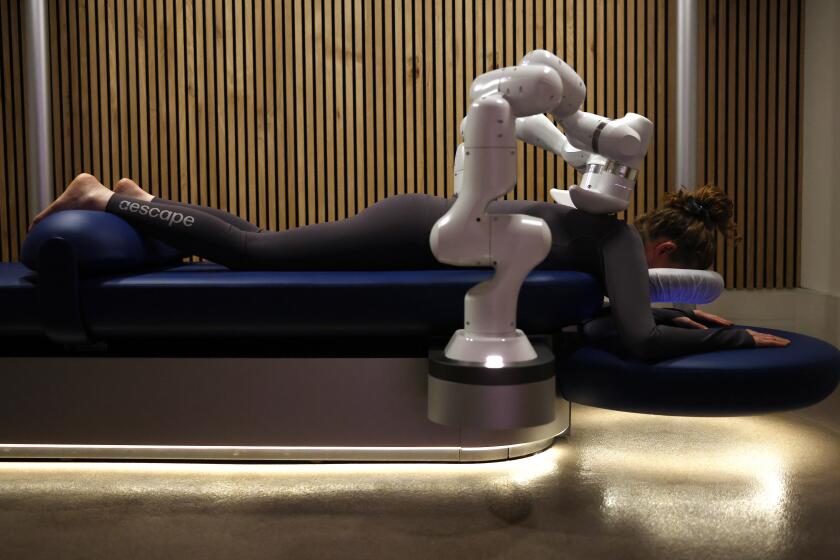Visual effects artists aim to create better work environments
- Share via
They called it the zombie walk.
After midnight, when the coffee and Red Bull had worn off, Sari Gennis and her co-workers would take a brisk stroll to make it through their graveyard shift. For four months straight, often seven days a week, a team of visual effects artists worked 12-hour shifts to complete the 3-D conversion of movie blockbuster “Titanic.”
Gennis said the long hours aggravated a severe arthritis condition. She’d already had both knees replaced, and needed a third surgery, but couldn’t afford to take time off for the operation.
“If I continue these kind of hours, it could kill me,” the visual effects veteran said.
Visual effects is a booming business. Big-budget movies such as “Avatar,” “Transformers: Dark of the Moon” and “Tron: Legacy” can spend as much as $50 million on computer graphics that drive the action — and ticket sales.
But the artists who create the effects, crouched over computers using software to create digital images, complain they’re often employed in electronic sweatshops, work inhuman schedules and without health insurance or pensions.
Now some are fighting back, beginning an effort to lobby for union protection.
“We’re the golden egg,” said David Rand, a veteran visual effects artist who has worked on such blockbusters as “Transformers: Dark of the Moon “ and “Matrix Reloaded.” “We’re more responsible for the bottom line than any other part of the talent. Yet we’re treated like talent was back in the 1930s and 1940s.”
The mounting frustrations are fueling an ambitious effort by the International Alliance of Theatrical Stage Employees to unionize the visual effects industry nationwide.
IATSE President Matt Loeb said last year that organizing these workers — more than 10,000 of whom make their homes in California — was one of his top priorities as leader of one of Hollywood’s most powerful unions.
On Friday, union officials will meet with a group of workers from Sony Pictures Imageworks that is seeking to unionize.
An industry leader, Sony employs 400 to 500 visual effects workers. Sony employees say they are seeking health insurance and other benefits that are enjoyed by their peers who work on the studio’s animated movies. An Imageworks spokesman said the company “respects employees’ right to consider union representation,” but had no further comment.
Complaints of poor working conditions, while not common against large employers such as Sony’s Imageworks, Industrial Light & Magic or Rhythm & Hues Studios, are chronic at many of the smaller shops.
The Animation Guild is preparing a class-action lawsuit against several of them, alleging they are violating federal labor laws by routinely misclassifying visual effects artists as independent contractors or freelancers, even though they report to work, have a supervisor and use company equipment.
Union officials say some employers are withholding pay from workers for as long as 90 days and are using a payroll service that reduces wages by having employees cover payroll taxes that would normally be paid for by the employer.
“The entertainment industry is finding every possible way to make visual effects as cheaply as they can, but the only people who are suffering are the artists,” said Steve Kaplan, an organizer for the Animation Guild, which is part of IATSE.
Executives at small to mid-size companies say providing these workers with a union contract could put them out of business. Some visual effects artists are concerned that the union drive could force more work out of California at a time when global competition is fierce.
“You can’t get blood from the stone,” said Scott Ross, who ran ILM in the 1980s and was a founder of Digital Domain. “Any additional costs to doing business will tank [employers].”
Effects companies based in London; Vancouver, Canada; or Mumbai can take advantage of tax credits and cheap labor to underbid California-based firms. At least half a dozen California companies have shut their doors in recent years, pushing hundreds of visual effects artists out of jobs that pay $75,000 to $150,000 a year.
The outsourcing of jobs has forced many visual effects artists to lead a migratory existence. There’s even a website called Pixel Gypsies that caters to “VFX workers living away from home or from job to job.” Another, called VFX Soldier, features regular commentary about the plight of workers in the industry.
Eric Roth, executive director of the trade group Visual Effects Society, says visual effects artists are so poorly regarded that the film credits are typically listed below the caterer. “Artists don’t get the recognition that they deserve,” he said.
Effects veteran Rand has been among the outspoken critics. A former stock broker who launched his entertainment career in 1995, Rand was hired as a lead effects supervisor on the 2008 movie “Journey to the Center of the Earth.” But shortly before the work was completed, Meteor went bankrupt, leaving more than 100 artists being owed $1.3 million in back pay.
With the help of Canadian actor Brendan Fraser and the Canadian Labor Board, crew members eventually got most of their money. But the experience mobilized Rand, who began blogging about the problem.
“I would get emails from L.A., UK, everywhere, with these horror stories about not getting paid and horrible working conditions.”
One 20-year veteran recently shared his experience in a widely read post on the animation guild’s blog. “I’m a 40-year-old [expletive] VFX artist, who has no healthcare in a job that is literally killing me,” he wrote.
The matte painter, who asked not to be identified for fear of damaging his career, said he nearly died when he fell asleep at the wheel after working 75 consecutive days, up to 17 hours a day, doing visual effects work on “National Treasure: Book of Secrets.” The money was good — $1,000 a day — but the long hours were taking a toll. Three months after his car accident, he began experiencing chest pains and was rushed to the hospital. He said emergency room nurses initially didn’t believe he was having a heart attack because he was only 37.
As a freelancer, he didn’t qualify for the company insurance plan to cover his $100,000 in medical bills. His employer, the now-defunct Asylum Visual Effects, refused to hire him back. He found a new job on another blockbuster movie, but the hours increased — along with his blood pressure.
The New York native eventually returned to Asylum to work on “The Sorcerer’s Apprentice.” “We were working 14 hours a day and I had forgotten my meds at home,” he said in an interview. “I started to get chest pains and I told my supervisor I have to go home. She said, ‘No problem, we’re all about healthcare here. We had an incident a couple of years ago when a matte painter had a heart attack.’ She didn’t realize that it was me.”
As for Gennis, she’s off the graveyard shift and on a different project now that the 3-D “Titantic” has hit theaters. But she remains concerned about her future — and when she will be able to take time off for surgery. Recently, 65 of her colleagues were laid off. The rest, including Gennis, were told to take three days off, without pay.
“I just feel so tenuous about my situation,” she said. “There’s no security anymore.”
More to Read
Sign up for The Wild
We’ll help you find the best places to hike, bike and run, as well as the perfect silent spots for meditation and yoga.
You may occasionally receive promotional content from the Los Angeles Times.











